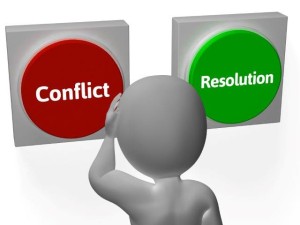 Another common challenge I hear about from leaders is resolving conflicts between employees. For some, they hate the idea of having to deal with conflicts in the first place. For others, they find it hard not to jump in and resolve the conflict themselves. In this article, let’s focus on when and how to resolve conflicts between employees.
Another common challenge I hear about from leaders is resolving conflicts between employees. For some, they hate the idea of having to deal with conflicts in the first place. For others, they find it hard not to jump in and resolve the conflict themselves. In this article, let’s focus on when and how to resolve conflicts between employees.
First, be sure there is a conflict to be resolved! If two employees are working through their differences – exchanging ideas, advancing the conversation, remaining polite and professional, listening and attempting to understand the other’s point of view, doing a little give and take – leave it alone! They are working it out! There is no need to jump in. They might be having a disagreement, but they are listening to each other and talking it through trying to come to a point where they can agree. However, let’s assume these two employees are not listening to each other, there is no give and take and, in fact, it is getting a bit contentious. It has become personal, they are angry and each is blaming the other. Step in! This is a conflict where you will need to get involved to resolve it before it becomes a serious business problem.
Now that we know when to step in to resolve conflicts. Let’s talk about the process for doing so.
You don’t want to resolve the conflict for the parties; they need to do that themselves. However, you will need to facilitate that conversation. Here are some best practice steps for facilitating a conversation between two employees to help them resolve their conflict:
- Arrange for a meeting with both parties. Try to find a neutral location where you will not be interrupted or disturbed.
- State your expectations (e.g., this conflict must be resolved and the parties need to leave on good terms) and do not allow for bad behavior (e.g., no arguing, shouting, blaming)
- Ask each party to state their view of the conflict. Be sure that they do not interrupt each other and listen to each other. Ensure that they “see” the conflict in the same way.
- Then, ask each party to share a few potential solutions to the conflict. You might contribute a few ideas to help them get started, but the goal is that they mutually develop and agree on a resolution.
Ensure that throughout the conversation the two parties in conflict use active listening skills, remain calm, and enable each other to speak. Keep helping them to advance the discussion toward a mutually acceptable resolution.
- When they have reached an agreement on how to resolve the conflict (this may take more than one meeting), have them work together to outline the steps that will be taken, ensuring mutual accountability and a deadline for resolution.
- Schedule check-in dates/times to ensure they are moving forward as agreed and are resolving the conflict.
Resolving conflicts is part of the job of any leader. It doesn’t have to be a stressful situation; just follow a few simple best practices to resolve conflicts sooner rather than later. Conflicts left alone only grow to be larger issues that will have an impact on the business as well as the team as a whole. Setting up processes and procedures for managing conflicts that arise will make resolution of conflicts much easier overall.
What are your best practices for managing conflicts between employees?



I agree that this can be a tough one. This can be hard to resolve if the problem had escalated so much that both parties don’t want to resolve it.